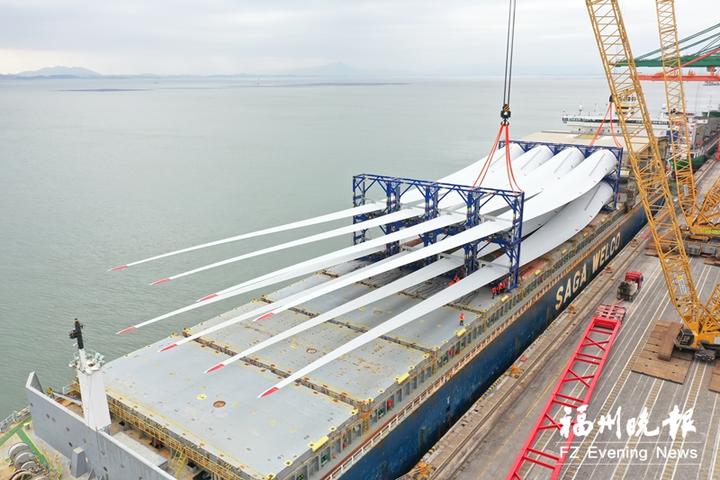Seafood, jasmine tea, offshore wind power equipment, fungus technology...
“Made in Fuzhou” highlights the Belt and Road Initiative
600 years ago, Zheng He’s “Sailing to West Ocean” pushed the development of the Maritime Silk Road to a new height. Today, the Shengshou Pagoda, which witnessed the sail, still stands in Nanshan, Changle, Fuzhou, witnessing the prosperity of the Maritime Silk Road in the 21st century.
In the autumn of 2013, the proposal to jointly build “the Belt and Road Initiative” was formally put forward. In the past 10 years, as a strategic fulcrum city of the Maritime Silk Road in the 21st century, Fuzhou, located in the southeast coast, has been deeply integrated into the overall pattern of building a “the Belt and Road Initiative” with a bold and open attitude, and has achieved fruitful results. Many Fuzhou products, technologies and services are spread to the world with the help of the initiative.

International abalone experts praised Lianjiang abalone.Photographed by Wang Weigang
“Made in Fuzhou” sells well on “the Belt and Road Initiative”
During this time, Kong Sijun, chairman of Fuzhou Import and Export Chamber of Commerce, was so busy.
At the end of July, Kong rushed to Nigeria to unveil and cut the ribbon for the Maritime Silk Road Cross-border New Retail Industrial Park of the Golden Diamond Industrial Park. This is another important measure to provide demonstration effect for Nigerian foreign trade import and export enterprises since Fujian Province and Kano State of Nigeria established sister relationship.
Later, he went to another Cross-border Park in Guangming International Free Trade Zone, Ghana to award license.
The successive landing of “cross-border parks” means that Fuzhou is closer to achieving the goal of “10 more cross-border parks” proposed in this year’s work report of the municipal government.
“Under the guidance of the ‘the Belt and Road Initiative’, Fuzhou Import and Export Chamber of Commerc has completed the construction of Fuzhou Cross-border Park Headquarters, Haishi Digital Intelligence Industrial Park, Vietnamese Shengli Headquarters and Indonesian Kangbang Headquarters in China, and built Russian Jorya Gathering Center, Ghana Guangming International Free Trade Zone, Argentine Dino Casta Industrial Park, Nigerian Home Garden, Indonesian Building Materials Industrial Park, Philippine Photovoltaic Industrial Park, and Cross-border Park Headquarters and other overseas. It is estimated that the goal of building 20 ‘Cross-border Parks’ will be completed by the end of this year.” said Kong.
Since the initiative was put forward, more and more Fuzhou enterprises have “gone global”. It is understood that in 2022, the total import and export volume of Fuzhou will be about RMB 360 billion, of which more than one third (RMB 125.5 billion) will be the countries and regions jointly built by the initiative, with a year-on-year increase of 14.6%.
Such achievement is the result of Fuzhou seizing the great opportunity to jointly build “the Belt and Road Initiative”, deeply integrated into the construction of Maritime Silk Road Core Area, and promoted the construction of Maritime Silk Road strategic fulcrum city.
On the one hand, Fuzhou will strengthen its seaport and airport and improve its infrastructure. Last year, the cargo throughput of Fuzhou Port exceeded 300 million tons, ranking among the top 20 ports in the world, and a number of “Silk Road Shipping” routes were opened. The passenger throughput of Changle International Airport exceeded 10 million passengers, and the role of the gateway hub became more prominent.
On the other hand, Fuzhou promotes land and sea connectivity and creates favorable conditions. The “Mindu” trains from Central Europe and China, realizing the effective connection between Maritime and Land Silk Roads, and Fuzhou has become an important node city to jointly build “the Belt and Road Initiative”.
In addition, Fuzhou has increasingly close cooperation with countries and regions that have jointly built “the Belt and Road Initiative”. At the beginning of this year, Fuzhou economic and trade exchange delegation visited Indonesia, Malaysia and the Philippines and signed 24 key projects with a total amount of more than RMB 49 billion.

Offshore wind power equipment will be exported to countries and regions jointly building “the Belt and Road Initiative”.Photographed by Xue Youxiong
Fuzhou jasmine tea fragrance on “the Belt and Road Initiative”
Tea originated in China, and jasmine originated in the west. Jasmine tea originated in Fuzhou is not only a witness to the cultural exchange and integration between the East and the West, but also a link between Fujian and countries and regions that have jointly built “the Belt and Road Initiative”
Fu Tianfu, president of Fujian Chunlun Group, told the reporter that following the activities of Fujian Tea Sea Silk Tour held in 2016, Fujian Chunlun Group’s “footprint” spread all over Russia, Malaysia, Singapore, Britain, France, Belgium, Australia and other countries and regions. Fuzhou jasmine tea has a unique taste and profound cultural heritage, and has attracted people in many countries.
With the development opportunity, Chunlun Group actively expanded overseas markets and took the lead in entering Europe. In 2016, Chunlun Group set up a branch in France and entered a Michelin-starred restaurant on Champs-Élysées who recommends jasmine tea as an after-dinner drink to customers and promotes Fuzhou jasmine tea to integrate into French food culture.
“In the menu of Michelin 3-star restaurant in Paris, France, a cup of jasmine tea costs 28 euros.” Fu said that with the French branch as the center, the sales network of Chunlun Tea has now spread all over Russia, the European Union, Southeast Asia, Japan and other places.
Fungus technology helps to build national development.
The emergence of fungus ended the history that Fiji could not grow mushrooms. “It’s fascinating that fungus can bring us employment and lift us out of poverty.” Local farmers in Fiji said.
This is one of the cases in which fungus have gone from Fujian to the world.
In Fiji, fungus technology is known as “the new hope of island agriculture” In Rwanda, more than 3,500 families participated in the production of fungus, and many farmers increased their income by planting fungus... Now, fungus has changed into “happy fungus” for many countries.
Since going abroad in 2000, the fungus technology has built friendship in 106 countries and regions around the world, and achieved win-win results, providing a “China plan” for developing countries to solve development problems and contributing “China wisdom” for the world.
At present, under the leadership of Lin Zhanyi, the fungus technology has expanded to the fields of ecological management, fungus feed, materials and biomass energy development of fungus.
Fungus technology has become one of the important public goods provided by China to the international community, and it has spread to more than 100 countries, and has been written in five white papers, such as “Building the Belt and Road Initiative Together: Great Practice of Building Community of Shared Future for Mankind” issued by the State Council Press Office.
According to the team of the National Fungus Engineering Technology Research Center in Fuzhou, the fungus technology has brought a real sense of gain and happiness to hundreds of thousands of people, and enhanced the poverty reduction ability and people’s livelihood and well-being in countries building a “the Belt and Road Initiative”. (Fuzhou Evening News reporters Jiang Hai, Zheng Ruiyang, Xu Wenyu, Chen Muyi, Wang Guanghui and Liang Kaihong)